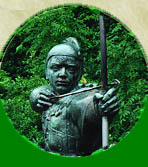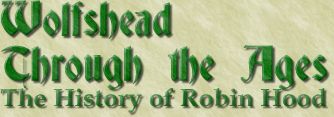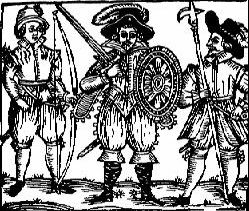CHANGES TO THE LEGENDThe Tudor period not only elevated Robin's social status. The outlaw, much like his native country, underwent a religious conversion. Although he'd rob corrupt abbots, monks and bishops, the early Robin Hood was a devout Catholic (at least in irony). Even into the reign of James I, the Catholics behind the 1605 Gunpowder Plot to blow up Parliament were called "Robin Hoods". Yet England had broken away from Rome in the 1530s. Sometimes, the dominant religion of England seemed like little more than Catholicism without the Pope. Other times, it was as Puritan or more Puritan than the European forms of Protestantism. And somewhere, in the shifting of religions, Robin came to represent a Protestant before his time.
While his primary adversaries may have been the church, it should also be noted in Parker's True Tale Robin and Little John "not dreading law" rob the king's receivers of their gold. Robin Hood did not steal the king's taxes in the early ballads, but it would become part of the modern legend, and one used to politicize the story. While he may have been depicted as a good Christian (whether Catholic or Protestant), Robin kept getting in trouble with god-fearing folk. For example, Mary, Queen of Scots banned Robin Hood plays in 1562. She wasn't the only one. Just before the Civil War, Ben Jonson (a famous playwright and drinking buddy of Shakespeare in the Bard's last years) used his Robin Hood play, The Sad Shepherd , to criticize the Puritan movement's way of looking down on so-called "Pagan pastimes" as the courteous shepherd Lionell explains to Tuck:
Jonson never finished The Sad Shepherd, although later writers have offered conclusions to it. The play features the now-familiar cast of characters, Robin, Little John, Tuck, Scarlet and Scathelock (brothers as in Munday's play), Much and of course Marian. It also features an evil witch Maudlin, who impersonates Marian, and her servant Puck-Hairy. The play does feature some lusty fliration between Robin and Marian, even though Robin is largely sidelined from the action. Speaking of Marian, as Stpehen Knight and others have noted, a key influence on Jonson was Michael Drayton's topographical poem Poly-Olbion. Drayton describes Marian thusly:
That 17th century description of Marian might surprise some who may only think of the character as a damsel-in-distress. However, let us return to the political situation of the 1640s. In the Parliamentary elections of 1640, a new party was formed -- the Robins. The candidate even assumed the alias of "Robin Hood". That candidate was "the Puritan gentleman Alexander Popham, a highly appropriate Robin Hood, some thought, because he was under sentence of outlawry for debt." Popham lost, but his supporters (called Little Robins and Little Johns) took Parliament's side in the coming conflict. [David Underdown, Revel, Riot and Rebellion , p. 135] In 1641, the Puritan forces in the Parliament got fed up with King Charles I and kicked off a little fracas known as the English Civil War. [King Charles raised his standard in Nottingham, although the town later sided with Parliament.] This ended with Charles I being beheaded in January 1649. For 11 years, England had no king in a period known as the Interregnum. The Puritans set up the Commonwealth and Protectorate led by Oliver Cromwell. During this period, the government banned May plays [like Robin Hood's once participated in] along with Christmas, Easter, and anything else that was "pagan", "Catholic", "licentious", "rowdy" and basically fun. However, in 1652, a traditional Robin Hood game was performed in the Oxfordshire village of Enstone -- without incident. Also, Robin Hood ballads still circulated in this period. The radical movements of the Levellers and the Diggers (aka "True Levellers") both compared the social abuses in their time to the ideas of the Norman Conquest and the Norman Yoke. Despite that the Normans were commonly used as an allegory for the woes of society, the Robin Hood of this period still did not fight Normans as he would in the 19th-century onwards. Perhaps the use of the Norman Yoke by radical movements kept references of Normans out of the more mainstream Robin Hood ballads of the day. In 1660, the late Oliver Cromwell's son Richard (Tumble-Down Dick) lost control, and King Charles II was brought in as the new king. This kicked off a period known as the Restoration, and as usual, Robin came along for the ride with many new plays and ballads. Nottingham was a trouble spot during the Civil War. The medieval castle had been damaged in the fighting. They'd just sent one of Cromwell's supporters back to Parliament. And the folks in Nottingham wanted to show their support for the king. Hence, a curious play Robin Hood and his Crew of Souldiers was produced. A messenger from the Sheriff of Nottingham popped by to tell Robin and his Roundhead-ish rebels that a new king has come. Robin recants his rebel ways and decides that they should support the new king. These aren't the only times that Robin Hood has been used for propaganda. In Robin Hood's Fishing (aka The Noble Fisherman or Robin Hood's Preferment), Robin takes to the seas as a second-rate fisherman, and ends up stopping French pirates. And in 1727, the buffoonish Robin Hood of the popular street ballads came to represent and lampoon Sir Robert Walpole, the powerful and corrupt Prime Minister, in Robin and the Duke of Lancaster . In the reign of James I, there was a Robin Hood club for political and philosophical discussion. And as in 18th century there was a Robin Hood Society, a weekly mechanics meeting where, to quote British historian Christopher Hill, "deists, Arians, Socinians and Jews were said to air doubts about the resurrection, the incarnation, the Trinity ('their everlasting butt'), the authenticity of the Scriptures and of the Gospel miracles." [Hill, Liberty Against the Law, p.80] There was a branch of this society in America as well. As you can see, Robin Hood could suit any number of political purposes. NEXT: Broadsides and Buffoonery (a look at the later ballads) Sources and Further Reading: Click here to view additional information sources used for this specific section. Text copyright, © Allen W. Wright, 1997 - 2004. |
|

|

 For example, the church was behind Robin's downfall in Munday's play.
Martin Parker's
For example, the church was behind Robin's downfall in Munday's play.
Martin Parker's 